#House of Besenval
Explore tagged Tumblr posts
Text
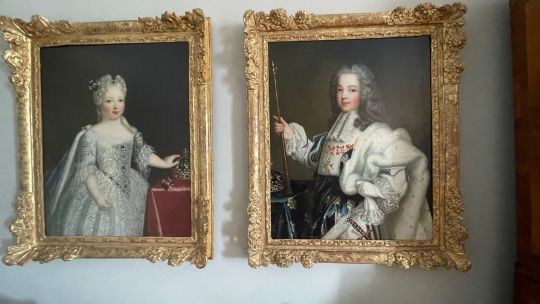
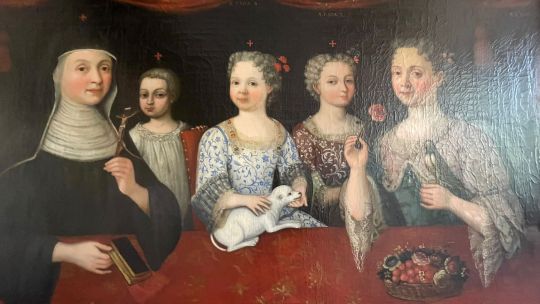
Mariana Victoria of Spain and her fiancé, Louis XV and daughters of the House of Besenval at Schloss Waldegg. Photos taken by me.
17 notes
·
View notes
Text

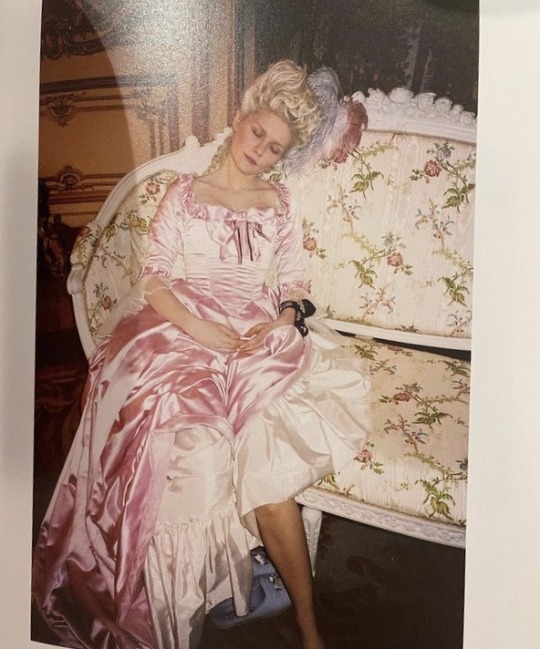
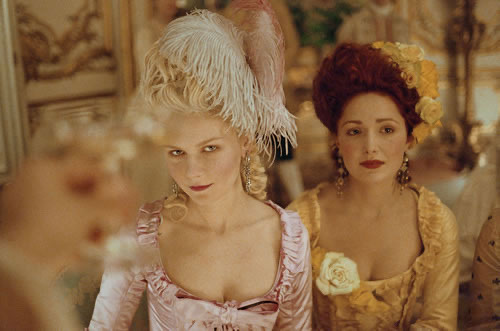
(Note: I did a post on this scene a while back but I decided to revisit it with additional analyses and the true script pages attached.)
Scene 82 from the original 2004 script for Sofia Coppola’s Marie Antoinette (2006) is one of several that ended up being cut from the film. We know that it was shot thanks to several promotional stills and behind-the-scenes photographs that have surfaced over time (we got the famous photos of Kirsten smoking in costume from the shooting of this scene — one of the first glimpses we got of the production), but, unfortunately, no footage of it has ever been released.
The context of the scene is that it takes place shortly after the accession of Louis XVI and Marie-Antoinette (1774) and before the visit of MA’s brother, the Emperor Joseph (1777). These years, her early 20s, were marked by a growing sense of confidence, no doubt inspired by her transition from dauphine to queen consort. MA established an intimate circle of her choosing (The Private Society) in defiance of protocol, collaborated with Rose Bertin to produce various styles of dress, all far more adventurous than the traditional court styles, and threw herself into the pleasures of opéra balls, gambling houses, horse races, and the privacy of Trianon, all while attempting to produce her first child with Louis. Words like frenetic, légèreté, and hedonistic typically get thrown around by biographers when discussing MA’s behavior during this period, to highlight a sense that the queen was uncontrollably flighty and inattentive.
There is deep misogyny in the dismissal of MA as simply lightheaded and frivolous during this time. In more fair terms, this is a 20-year-old who had just gone from four years in a new, unwelcoming environment, surrounded by a cast of characters who were not exactly always desirable company, behaving from sunrise to sunset according to famously difficult etiquette practices, finding herself faulted, on a near daily basis, with her failure to conceive, and generally struggling to find her place. Now, with this burst of freedom that has come with becoming a queen consort, she has granted herself the permission to seek amusements (especially in Paris, still a virtually unexplored city to her), to enjoy playing with her appearance on her own terms, and to befriend whom she pleases.
Sofia Coppola does a wonderful job at portraying MA in this light, almost, in a modern sense, as a young girl who has just become an adult and moved out of her parents’ house and is enjoying newfound freedom.
Scene 82 would have followed the Birthday Party sequence that remains in the final cut of the film. Very significantly, it is preceded by a short insert of a pornographic libelle, of the variety that began circulating around this time (1774) that showed MA in a very unflattering light (lavish, lascivious, a tribade, etc.). This was also cut from the film, as were other inserts that show up in the original script. The libelle that the screenplay is referencing here is «Le Lever d’Aurore», which took her innocent sunrise excursion into the gardens of Versailles with friends, chaperoned by the comtesse de Noailles, and corrupted it. What was inspired by the Incan devotion to the sun and conducted in adolescent reverie (and in the film is shown as an after-party to MA’s 18th birthday), became a bacchanalia, showing MA and her friends hiding in the shrubbery of Versailles with a variety of lovers, both male and female. The insert was there to remind the audience that the public and private perceptions of MA’s lifestyle and conduct were of two very different varieties.
The fact that Scene 82 follows the inserts may be intentional, as if to suggest that the scene is not entirely accurate (in the same way that the opening shot of MA reclining in splendor and the “Let them eat cake” line are supposed to be fantasy depictions of the queen, not accurate ones).
As you can see in the script pages, Scene 82 is another gambling party that takes place in the queen’s apartments. But this one is different from the one that comes almost directly before it. The conversation, presented as Polignac entertaining MA with sordid tales of the courtiers present as well as with stories of her own sexual experiences, is much more adult and licentious than the conversation at the 18th birthday party. Louis XVI is present at the opening of the scene but retires quickly, and Lamballe is not featured, only referenced. Tom Hardy’s Rohan (not be confused with the factual cardinal de Rohan), makes an appearance, which would have been his first feature in the film, before his involvement at the later Trianon segment.
The idea here is that this intimate circle, in direct adjacency to MA, is perhaps not the most suitable for her to surround herself with, which was a constant complaint against her by those on the outside. But the sexually explicit conversation, Polignac’s morality, and the looser feeling of this party in comparison to the many others in the film may be interpreted as this scene being presented to the audience as intentionally questionable … Is this another fantasy sequence, a party thrown in as seen from the perspective of the courtiers projecting depraved, adulterous behavior at the queen and her company?

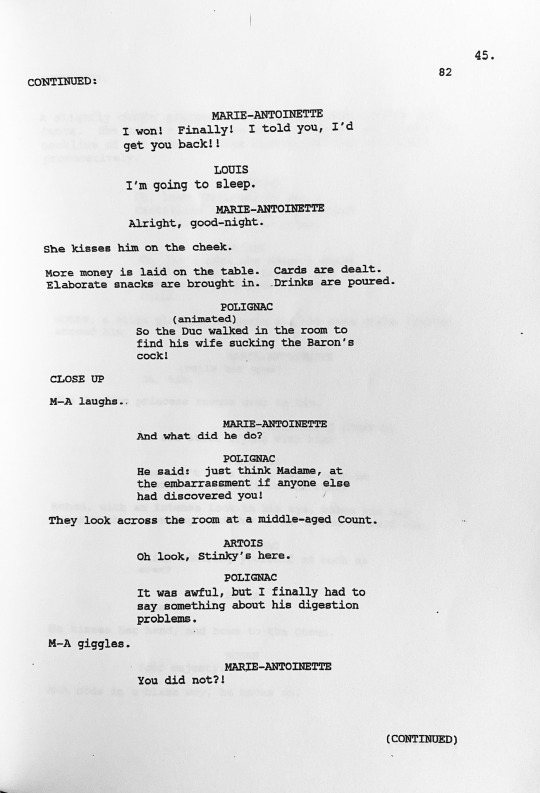

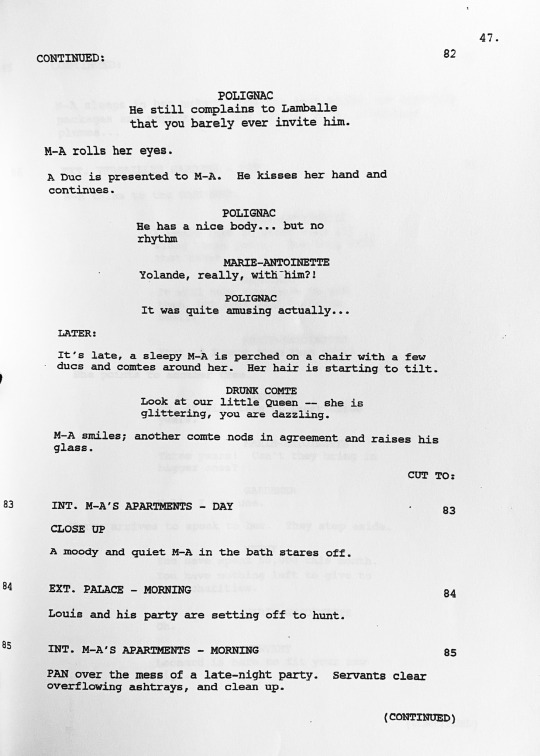
Significantly, MA is very much an observer in this scene, watching and listening but not involving herself in any reproachable behavior, which is an accurate portrayal. During the early years of the reign, she enjoyed the company (in addition to Lamballe, Polignac, and a few of her in-laws) of various older men of the court, almost all foreign and all able storytellers who regaled their young queen with stories of their experiences across the Continent. The baron de Besenval, the princes de Ligne and de Lauzun, the comte d’Esterházy, and the ducs de Coigny and de Guînes were all invited into the queen’s private apartments to entertain her with anecdotes of their travels and conquests, from Hungary to Switzerland and elsewhere through the European courts. None of them were considered suitable to be so intimate with MA according to etiquette, and she was severely faulted for this behavior by the royal court. She did not, however, ever allow herself to pass further than innocent flirtation with these men — Antonia Fraser speaks of the hysteria that MA had around her chastity. She sought the company of amusing, older men, but never in the context of adulterous behavior. They made her laugh and brought her levity, but if any of them ever crossed the line, they were very sharply and publicly reprimanded for their conduct.
One of the promotional stills for Scene 82 shows MA asleep, surrounded on all sides by men of the court, one of whom appears to be touching her. The image is another reason why perhaps this scene is supposed to walk the line between reality and fantasy … MA did surround herself with these men during her gatherings, but the physicality of the tableau suggests a bodily intimacy with these men that is definitely more in agreement with the vicious falsehoods spread by uninvited courtiers rather than historical fact. The scene feels out of place, as if the tone of this party isn’t consistent with the rest of the film — the conversation and behavior is much more extreme than anything else in Marie Antoinette, and this is perhaps intentional.
Why the scene was cut we do not know. It could have been due to pacing issues, since, with its inclusion, there would have then been two gambling parties back-to-back (which, again, may have been intentional — a more factual gambling party followed by a shocking illustration from a libelle, which is then followed by a fantasy gambling party to remark upon the different perceptions of MA’s lifestyle). It could be that the conversation was felt to be too vulgar, or at least vulgar in a way that stands out too much from the rest of the film. Or perhaps another reason entirely.
But the scene is important, as it’s a glimpse into what the public was guided to believe was the typical behavior of the queen of France, encouraged by the hands of the courtiers who were uninvited or ignored by MA.
Hopefully one day we get footage of this scene. I’m also curious if this scene was ever fully edited or if it was cut from the film before post-production was thoroughly on its way.



166 notes
·
View notes
Photo
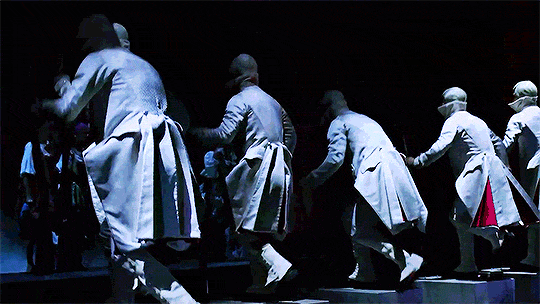



↳12 July, 1789 - Lambesc’s Charge
Months of unrest in Paris reached a fever pitch on the 12th, with the Prince de Lambesc, under the orders of the Baron de Besenval, ordering the Royal Allemand cavalry regiment to advance into the Tuileries in order to disperse a crowd that had gathered around the Place Louis XV (later Place de la Concorde). While there were no fatalities (although several people were injured, including an old man who Lambesc struck with his saber as he was trying to close the swing-bridge that connected the Tuileries to the Place Louis XV), word quickly spread through Paris, causing mass panic over the reputed massacre. The public feared more was to follow, heightening and adding a sense of urgency to the frantic search for arms that would end with the taking of the Bastille on July 14 in order to attain the gunpowder housed inside it. The Prince de Lambesc himself was popularly hated, with his alleged bloodthirstiness, treachery, and lechery being the frequent topic of satirical pamphlets in the early days of the Revolution. He would never set foot on French soil again, even though he would be tried and found innocent in absentia for his actions, dying in Vienna on November 21, 1825.
In-musical, the responsibility for the escalation of violence is instead given to the fictional Lazare de Peyrol, who is given the command by Louis XVI to “restore order by any means,” with Danton later mentioning that dragoons have stormed the Place Louis XV and that there are casualties, with Lazare himself appearing in the flesh to bloodily attempt to put down the crowd during “Nous ne Sommes.” Even though many of the specifics of the attack don’t fit with the accepted facts of the charge (both by pro-Royalist and pro-Revolutionary sources), it does have echoes of the popular idea of Lambesc, that of an aristocrat brutally enforcing his will on a people who are gradually becoming aware of their rights and, perhaps most importantly, their own emerging power.
Sources:
Samuel F. Scott, The Response of the Royal Army to the French Revolution
Paul G. Spagnoli, “The Revolution Begins: Lambesc's Charge, 12 July 1789″
Michael Arin, Nobility v. Nation: Conflicting Justices in the Early French Revolution Trials of Lambesc, Besenval, and Favras (1789-1790) (Senior Thesis)
#1789 les amants de la bastille#french revolution#fancast (sort of? Lazare's attack is pretty obviously based on Lambesc's)#perioddramaedit#frev#lazare de peyrol#prince de lambesc#charles eugene prince de lambesc#guns tw#flashing tw#long post#my gifs
76 notes
·
View notes
Text

Bedroom at Schloss Waldegg in Solothurn, seat of the House of Besenval, vassals of the Kings of France. Photo taken by me.
9 notes
·
View notes
Text

Stained Glass Window with the Besenval coat of arms at Schlosskappelle Waldegg. Photo taken by me.
4 notes
·
View notes
Text

Painting of Marie Leszczyńska, Queen of France and Navarre, at Schloss Waldegg in Solothurn, Switzerland. Photo taken by me.
#Marie Leszczyńska#Maison de Bourbon#Polish Princess#Reine de France et Navarre#Schloss Waldegg#Solothurn#House of Besenval#Consort of Louis XV
6 notes
·
View notes
Text

Wall panel at Schloss Waldegg in Solothurn. Photo taken by me.
6 notes
·
View notes